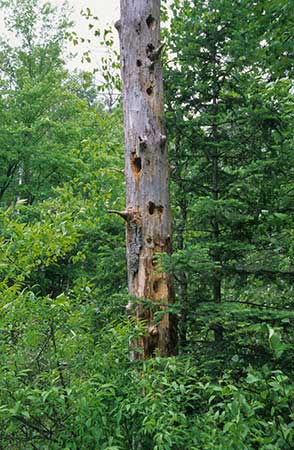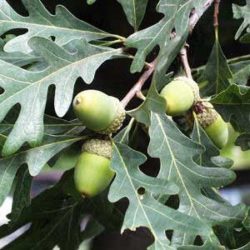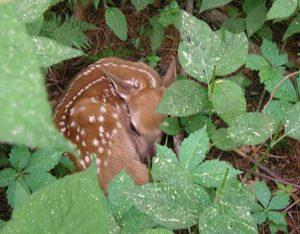Wildlife
How do I attract more wildlife?
By Rick Horton, National Wild Turkey Federation, and Steve Swenson, Aldo Leopold Foundation

Many landowners say that seeing wildlife is among the things they most enjoy about their land, whether it’s turkey or deer during the hunting season, or migrating songbirds in spring and fall.
Attracting birds and mammals with specific habitat needs often requires managing your land in certain ways, and financial assistance is available to help you do this.
The key questions are: What’s missing here that animals need, and can I provide it so they will spend more time on my property? To answer this, you’ll need to think about the habitat requirements of the species you’re interested in both at different scales (e.g., local versus regional) and at different times of year.
The big picture
The first step is to see where your property fits into the larger landscape by examining aerial photos or Google Earth images. This is because your land is typically just part of the “home range” for a wildlife species: the total area the species regularly travels to meet its yearly needs.
You’ve likely already seen deer roaming between your property and your neighbor’s. But smaller animals also cross property lines. Some song birds need uninterrupted tree cover to set up a breeding territory, whereas others prefer a mixture of forest types and age classes. So these territories may be the product of both yours and your neighbors’ land.
Trends at a regional scale can also have large effects on local wildlife. For instance, landscapes with more “edge habitat” – places where different land uses, such as woods and farm fields, meet – are better for certain species than others. Deer, northern cardinals, and cowbirds all prefer edge, while wood thrushes and scarlet tanagers need large patches of woods.
Bird populations can be strong indicators of regional changes both because they’ve been studied for so long and have very specific nesting requirements. Across Southwest Wisconsin, for example, the whip-poor-will has declined sharply due to loss of its preferred habitat: oak woods and oak savanna.
What does wildlife need?

Water, food, shelter, and space are the basic needs of all wildlife. However, these needs vary greatly among species, and individual species will have different needs at different times of year.
Water
Drinking water is usually not a concern for wildlife in Wisconsin. Some animals rarely drink, getting water instead from the foods they eat or as a byproduct of metabolism. For the rest, a creek, lake, or marsh is usually nearby. However, landowners can increase local wildlife diversity by creating a pond with abundant vegetation around it.
Food
Food for wildlife varies both year-to-year and seasonally. A favorite food, for example, are the nuts and berries of trees and shrubs, or “mast.” Packed with fat, protein, and carbohydrates, mast gives birds and mammals the energy they need to migrate, hibernate, and raise young. For this reason, its availability year-to-year can have a big impact. A bumper crop of mast will often boost populations of small mammals, which in turn benefits forest carnivores that prey on them.
What animals eat also changes seasonally. Robins feed on insects and worms during the summer, then switch to fruits in fall. Similarly, ruffed grouse and deer feed on all kinds of vegetation during summer and fall: buds, fruits, mushrooms, and greens. In winter, however, deer browse exclusively on shrubs, white cedar, and other woody material, while grouse feed on the flower buds of mature male aspen, birch, or hazel brush.
Thus, the land will support more animals if food is managed at critical times. In the case of deer and grouse, brush can be piled near deer yards and clones of male aspen retaining in harvested areas.
Shelter

Good wildlife habitat provides animals with cover to escape predators and shelter from the weather. It can take many forms, including brush piles, thickets, marshes, burrows, and standing, dead trees (snags).
To protect themselves from winter cold, many Wisconsin animals also seek dense stands of lowland conifers, which limit radiant heat loss, break the wind, and reduce snow depths.
Fallen logs and branches are also important habitat. Amphibians, such as wood frogs and salamanders, use the cool, moist spots under logs as shelter and forage areas. Hooded and Kentucky warblers eat insects living in the wood.
Another benefit of dead woody material is that it offers many birds and mammals and some reptiles and amphibians sites for breeding and nesting. Red-headed woodpeckers, for example, nest in the cavities of snags in semi-wooded conditions, while Eastern bluebirds nest in snags in open landscapes.
In short, while you may think that you should “clean up” your land by removing brush and logs, leaving them behind can be a big help to wildlife.
Space
Animals need a certain amount of space to meet all their annual needs and reduce competition for resources. For example, you wouldn’t expect a bear to live in a 20-acre woodlot, but it would be plenty for a pine squirrel. Bluebirds use about five acres of open grasslands while American kestrels need about 100 acres. So if you own a 50-acre field you might expect to have 10 pairs of bluebirds, but should not expect to support a pair of kestrels.
